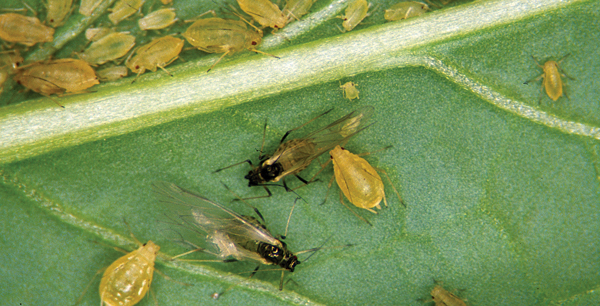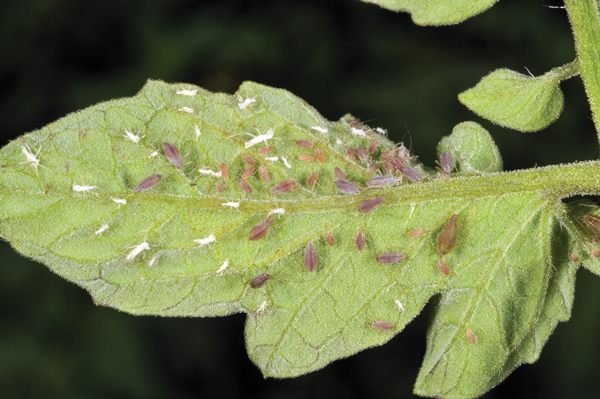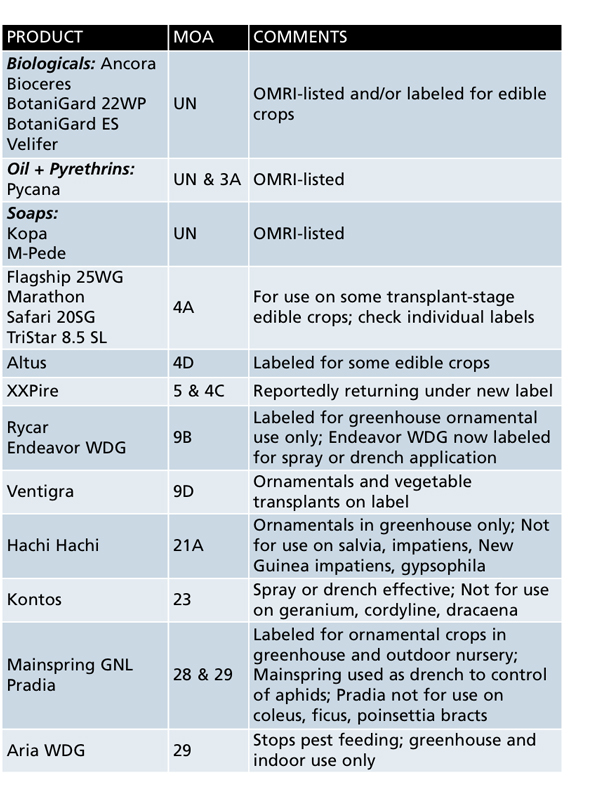11/1/2019
Under Siege!
Karen Stever

Aphids are a pest of economic significance to both ornamental and edible crops, with roughly 5,000 known aphid species living around the world. Some aphid types only feed on a specific plant genus, like crepe myrtles or hops, but the vast majority of aphids are far less selective.
Pictured: Winged and wingless Green Peach Aphids.Photo credit: Whitney Cranshaw.
Plants known to be prone to aphids include ageratum, alyssum, aster, celosia, chrysanthemum, dahlia, Easter lily, gerbera, herbs, fuchsia, hydrangea, impatiens, mandevilla, pansy, pepper, portulaca, primula, salvia, snapdragon, tomato, verbena and zinnia. If this list sounds like your spring production plan, please read on. If not, you may still want to continue.
Once you know that 260 species of aphids have been documented on artemesia alone, you may wonder if (and when) your crops will get aphids this year. Practically speaking, no spring crop is immune to aphid infestation—some are just less favored. It’s good to be prepared. Aphids attack all above-ground plant parts. In addition, some aphid types also feed on roots or bulbs.
Aphids give birth to live young without the need for male fertilization. As aphid nymphs settle in for their first meal, they already have the next generation developing within them.
When aphids sense overcrowding or the need to move to another food source, they give birth to winged aphids that efficiently disperse to more distant plants. Once they’ve spread out, they go back to producing progeny with no wings. The reproductive rate of aphids is temperature-dependent; as the first warm days of spring accelerate crop growth, aphids ramp up just as fast—or faster. It may seem that the aphids came out of nowhere, but the truth is that it doesn’t take many undetected aphids to turn into a major infestation.
Aphid adults can overwinter on weeds or plants, even in an unheated greenhouse. Outside, they overwinter as eggs to ensure their survival. In spring, they can also be brought in on wind currents (similar to thrips), as well as purchased plant material. At the end of the growing season, be sure to remove all remaining plant debris and weeds; even small amounts of lingering plant material can harbor aphids for future re-invasion.
 Aphid feeding can cause distorted growth and lower leaf drop. Aphids also transmit many economically important plant viruses, such as CMV (a significant disease of calibrachoa and petunia) and a majority of the viruses found in vegetable crops. In addition, the sugary excrement aphids leave behind, called honeydew, will grow unsightly black sooty mold. In fact, this sooty mold and the white “skins” of exoskeletons shed as aphids mature are often the most obvious signs of an aphid infestation. Scouting the tender new growth tips and the underside of the leaves weekly will often identify a problem before plant damage occurs. Watch for ladybugs and ants during scouting, as their presence can also signal the presence of aphids.
Aphid feeding can cause distorted growth and lower leaf drop. Aphids also transmit many economically important plant viruses, such as CMV (a significant disease of calibrachoa and petunia) and a majority of the viruses found in vegetable crops. In addition, the sugary excrement aphids leave behind, called honeydew, will grow unsightly black sooty mold. In fact, this sooty mold and the white “skins” of exoskeletons shed as aphids mature are often the most obvious signs of an aphid infestation. Scouting the tender new growth tips and the underside of the leaves weekly will often identify a problem before plant damage occurs. Watch for ladybugs and ants during scouting, as their presence can also signal the presence of aphids.
Pictured: Aphid colony and cast skins. Photo credit: Purdue Extension.
The wide range of host plants and explosive reproductive capacity of aphids make them tough competitors for chemical and biological control programs. Scouting for early detection is very important, no matter which route you choose. Even effective chemical control may leave anywhere from a few to a small percentage of aphids alive and well. The survivors can quickly build up a population.
Bi ological controls can be effectively used to manage aphids. Parasitic wasps should be released as the first crops are planted, long before aphid colonies are formed. Weekly or biweekly releases should continue for the duration of the crop cycle. The backbone of biological aphid control programs are parasitic wasps, Aphidius colemani and Aphidius ervi.
ological controls can be effectively used to manage aphids. Parasitic wasps should be released as the first crops are planted, long before aphid colonies are formed. Weekly or biweekly releases should continue for the duration of the crop cycle. The backbone of biological aphid control programs are parasitic wasps, Aphidius colemani and Aphidius ervi.
Generally speaking, A. colemani is used for the smaller species of aphids and A. ervi for the larger species. For broad-spectrum control of aphid species, mixtures of A. colemani and A. ervi are available, as well as mixtures with another parasitoid wasp, Aphelinus abdominalis. The mixtures containing A. abdominalis are the best choice for greenhouse tomato and medicinal crops.
The parasitic wasps can be layered with addition beneficial insects for rapid control at aphid hot spots. Aphidoletes aphidimyza is a midge whose larvae have a voracious appetite for aphids. Green lacewing (Chrysoperla carnea) larvae are general predators, which will consume aphids, as well as other prey. Biological controls come in various package types and sizes. Rates are based on the square footage of the treatment area; consult with your supplier for details.
Biological control organisms may be compatible with select pesticides, which can be used to combat hot spots as needed. Please check with your beneficial insect supplier or GGSPro to determine which products can be safely applied with the predators and parasitoids you’re using.
Pesticide resistance is a significant concern with aphids when using a chemical program. Formulate a spray rotation with at least three products from different modes of action (MOA) to help reduce resistance pressure. Products with mode of action UN are generally lower risk for development of chemical resistance. Such products may be used frequently without the level of usual concerns. They can also be used to stretch rotations of traditional chemistries, preventing overuse.
The table lists effective MOAs and products for aphid control. It’s vital that applicators read the entire pesticide label and follow specific directions and warnings. Products other than those mentioned here may be safe and effective. GT
Karen Stever is a GGSPro Technical Support Representative for Griffin. She can be reached at ggsprotech@griffinmail.com.